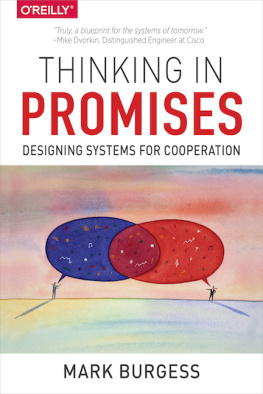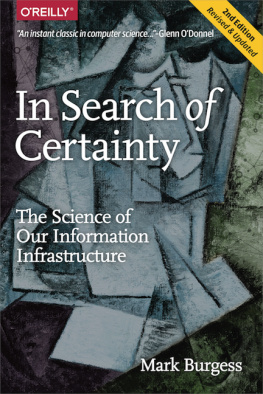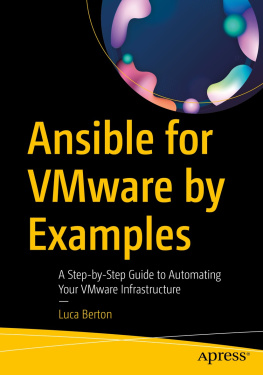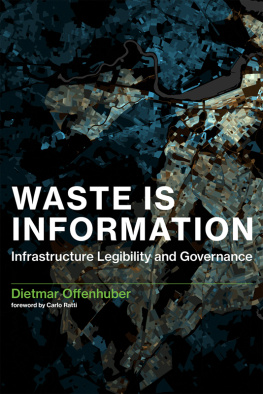I n S e a r c h o f C e r t a i n t y
T h e s c i e n c e o f o u r i n f o r m a t i o n i n f r a s t r u c t u r e
Published in ebook format by t Axis press 2013.
This edition published under the imprint t Axis press, Oslo, Norway
Reprinted with corrections January 2014, and March 2014.
Text and figures Copyright Mark Burgess January-June 2013.
Mark Burgess has asserted his right under the Copyright, Design and Patents Act, 1988, UK, to be identified as the author of this work.
Quotations used within this work are referenced from public sources, and pose no known commercial infringement.
Figures used by permission.
Sleeve design by Kristin Tobiassen, based on artwork by M. Burgess.
All rights reserved. No part of this publication may be copied or reproduced in any form, without prior permission from the author.
Dedicated to my friends,
who helped me to understand a little over the years.
Let the future tell the truth, and evaluate each one according to his
work and accomplishments. The present is theirs; the future, for which
I have really worked, is mine.
Nikola Tesla
For a successful technology. reality must take precedence over
public relations, for Nature cannot be fooled.
Richard Feynman
I dont want knowledge, I want certainty
David Bowie, Law (Earthling)
D y n a m i c s
Concerning forces and changes in the world.
S e m a n t i c s
Concerning meaning, interpretation and intent.
Contents
- Part 1: Stability
Or how we base technology on science - 1 King Canute and the Butterfly
How we create the illusion of being in control. - 2 Feedback Patterns and Thresholds
How the relative sizes of things govern their behaviour. - 3 Digilogy: Cause, Effect And Information
How transmitted information shapes the world from the bottom up. - 4 All The Roads To Nowhere
How keeping things in balance is the essence of control. - 5 Zero And The Building Blocks Of Babel
How to forge the atoms of reliable infrastructure.
- Part 2: Certainty
Living with incomplete information. - 6 Keeping It Together By Pulling It Apart
How weak coupling strengthened human infrastructure. - 7 Seeing Is Disbelieving
How to explain what we see and make use of it. - 8 The Equilibrium of Knowing
Or how not to disagree with yourself. - 9 Clockwork Uncertainty
The arms race between reason and complexity.
- Part 3: Promises
The chemistry of autonomous cooperation. - 10 The Concept Of Promises
Or why behaviour comes from within. - 11 The Human Condition
How humans make friends to solve problems. - 12 Molecular and Material Infrastructure
Elastic, plastic and brittle design. - 13 Orchestration And Creative Instability
Or why the conductor does not promise to blow every trumpet.
Introduction: The Hallowed Halls
Our great computers
Fill the hallowed halls Neil Peart, Rush, 2112
Quite soon, the worlds information infrastructure is going to reach a level of scaleand complexity that will force scientists and engineers to think about it in an entirelynew way. The familiar notions of command and control, which have held temporarydominion over our systems, are now being thwarted by the realities of a faster, denserworld of communication, a world where choice, variety, and indeterminism rule.The myth of the machine, that does exactly what we tell it, has come to anend.
Many of the basic components of information infrastructure, including computers,storage devices, networks, and so forth, are by now relatively familiar; however, eachgeneration of these devices adds new ways to adapt to changing needs, and whathappens inside them during operation has influences that originate from all over theplanet. This makes their behaviour far from well understood even by theengineers who build and use them. How does that affect predictability, theirusefulness?
It is now fair to draw a parallel between the structures we build to deliverinformation, and the atomic structure of materials that we engineer for manufacturing,like metals into structures that give themparticular properties. Similarly, information infrastructures are made up of theirown components wired into networks, giving them particular properties.Understanding what those properties are, and why they come about, requires a newway of thinking. In this book, I will attempt to explain why this analogy is afair one, why it is not the full story, but what we can learn from the limitedsimilarity.
At the engineering level, we put aside the details of why a structure behaves as itdoes, and rather make use of what properties the materials promise. We become moreconcerned with how to use them, as off-the-shelf commodities, and describe theirpromises in terms of new terms like strength, elasticity, plasticity, and so on,qualities far removed from raw atoms and chemicalbonds. The useful properties of materials and infrastructure lie as much inthe connections between parts, as in the parts that get connected, but weprefer to think of them as continuous reliable stuff, not assemblages of tinypieces.
The parallels between information infrastructure and the physics of matter godeeper than these superficial likenesses, and I have studied some of these parallels inmy research over the past twenty years. This book will describe a few of them.Understanding this new physics of information technology is going to be vital if weare to progress beyond the current state of the art. This is not the physics ofsilicon wafers, or of electronics, nor is it about ideas of software engineering;rather, its about a whole new level of description, analogous to the large scalethermodynamics that enabled the steam age, or the economicmodels of our financial age. Only then, will we be able to build predictablyand robustly, while adapting to the accelerating challenges of the modernworld.
*
What does this mean to you and me? Perhaps more than we might think. Everysearch we perform on the Internet, every music download piped to our earplugs froman embedded mobile hotspot, or more speculatively every smartphone-interfacingself-driving hybrid car purchased with a smart-chip enabled credit card, sendsus careering ever onwards in the uncontrolled descent of miniaturizationand high density information trawling that we cheer on as The InformationRevolution.
We no longer experience information-based technology as thrilling or unusual; thedeveloped world has accepted this trajectory, expects it, and even demands it. In thedeveloping world, it is transforming money, communications and trade in areas wheremore traditional alternatives failed for a lack of physical infrastructure. The ability toharness information, to process it, and at ever greater speeds, allows the whole worldto fend off threats, and exploit opportunities.
As information technology invades more and more parts of our environment, we aregoing to experience it in unexpected ways. We wont always see the computer in abox, or the remote control panel, but it will be information technology nevertheless.New smart materials and biologically inspired buildings already hint at what thefuture might look like. Yet, if we are to trust it in all of its varied forms, we have tounderstand it better.
For years, weve viewed information technology as a kind of icing on our cake,something wonderful that we added to the mundane fixtures of our lives, with itsentertainment systems and personal communications channels; but, then these thingswere no longer the icing, they were the cake itself. Information systems began toinvade every aspect of our environments, from the cars we drive to the locks on thefront door, from the way we read books to the way we cook food. We depend on it forour very survival.
Next page









